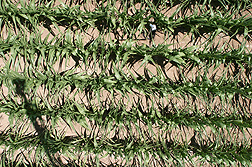| Read the magazine story to find out more. |
|
|
Taking the Temperature of Water-Thirsty Plants
By Dennis O'Brien
August 25, 2015
A U.S. Department of Agriculture (USDA) engineer in Fort Collins, Colorado, is making it easier for growers to determine if their crops are water-stressed.
Agricultural engineer Kendall DeJonge is trying to conserve irrigation water by using infrared radiometric thermometers (IRT)—sensors that can determine crop canopy temperatures and subsequently detect crop water stress.
Scientists interpret IRT data by using one of several indices, including the commonly used Crop Water Stress Index (CWSI). Developed in the early 1980s, the CWSI requires knowing the air temperatures and humidity levels and involves a fairly technical process.
DeJonge and his colleagues compared the CWSI with five other indices, or formulas, for interpreting IRT data to see how well they could detect crop water stress over 2 years in a corn-sunflower rotation. Two of the indices developed for the study, the Degrees Above Non-Stressed (DANS) index and the Degrees Above Critical Temperature (DACT) index, were simpler than CWSI. DANS is calculated by comparing a stressed plant's temperature to the temperature of a non-stressed plant in the same environment. DACT is based on an established crop temperature threshold, and plant water stress is determined by how many degrees the plant temperature reaches above that threshold.
In the study, crop canopy temperatures were taken each day around the clock but focused on 2 p.m., when water stress levels were usually the highest. The researchers also monitored soil water levels and crop water use, and fully irrigated part of the field, while intentionally stressing other areas.
The findings showed that the DANS and DACT indices were just as effective as CWSI at determining water stress even though they require much simpler measurements—a once-a-day reading of only crop canopy temperatures.
DeJonge plans to develop "crop water coefficients" that establish water needs of specific crops under different scenarios. With that data, IRTs could soon be more widely used by farmers. DeJonge foresees farmers using handheld IRTs in the near future—and eventually using IRTs with drones to calculate water needs over extensive areas.
Read more about this research in the August 2015 issue of AgResearch. ARS is the USDA's chief intramural scientific research agency.

